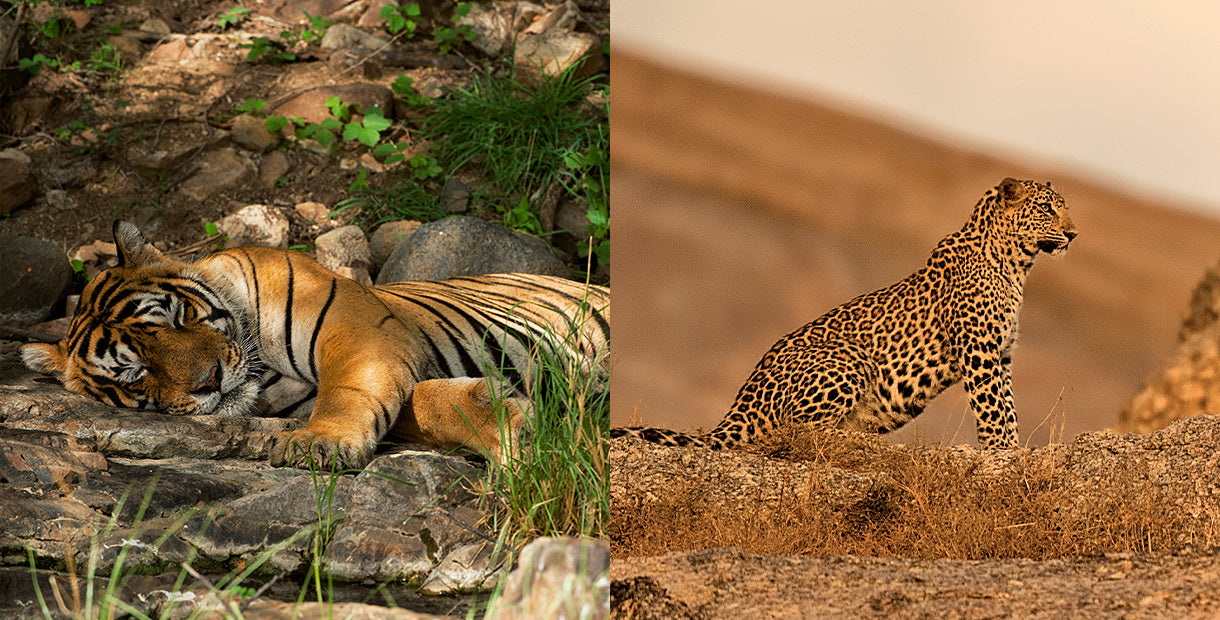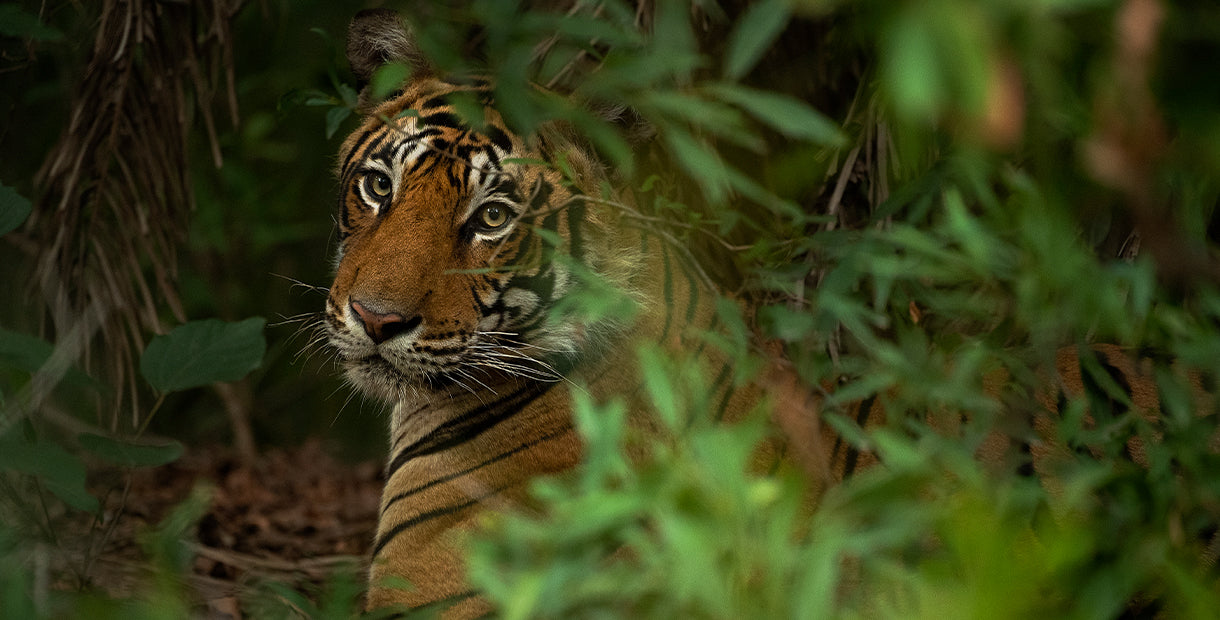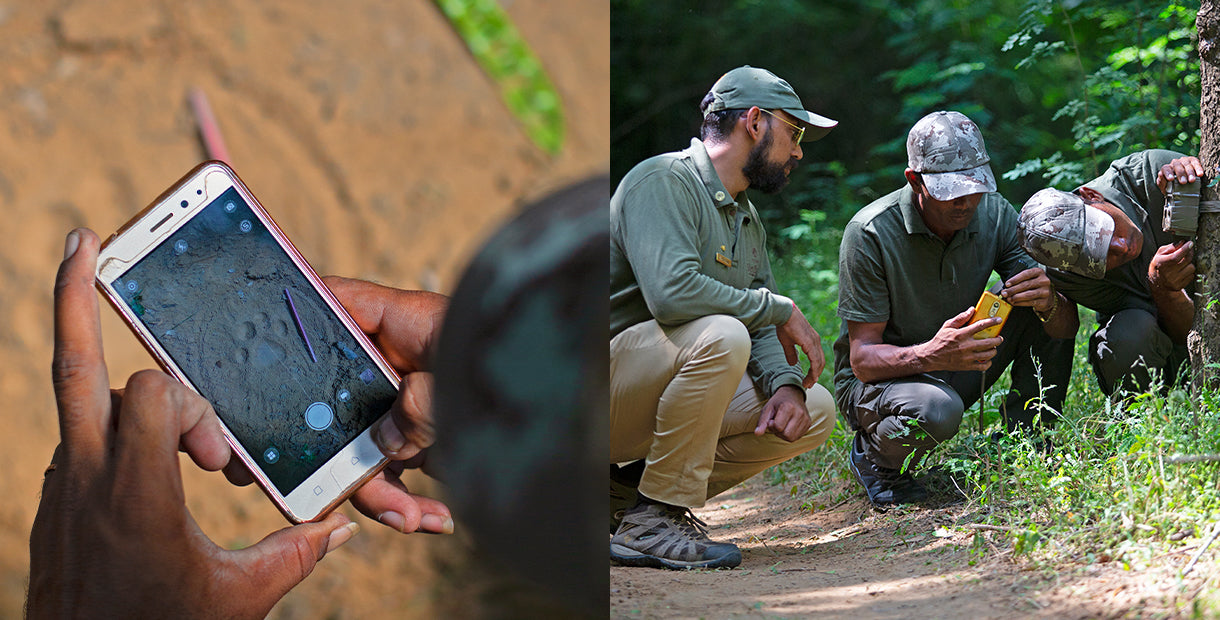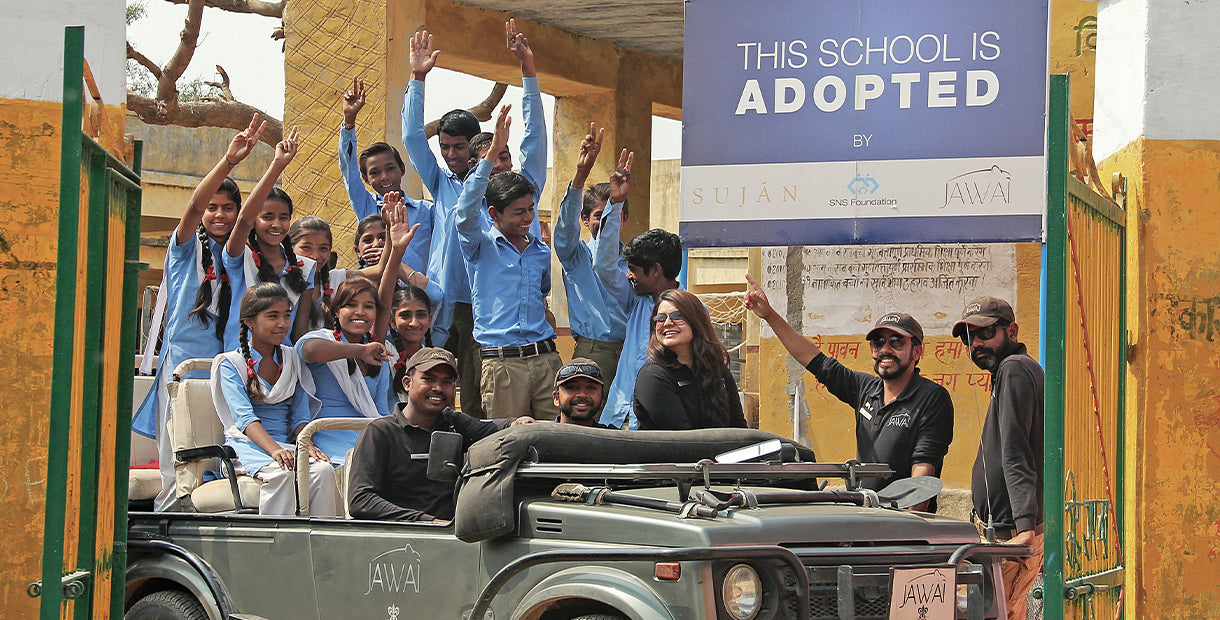
A Royal Bengal tiger in Ranthambore and an Indian Leopard in Jawai
The Challenge of Saving India’s Big Cats
Partners on our Fall '21 India’s Vanishing Species collection, SUJÁN Tiger and Leopard Conservation Projects work to save these endangered species in Rajasthan by empowering local communities.
Tigers and leopards are revered in Indian folklore and Hindu legend (the goddess Durga is often depicted riding a tiger)—and only 200 years ago, both of India’s iconic big cats roamed the subcontinent from north to south. But rapid population growth and modern development have dramatically shrunk wild habitat for both species, leaving them increasingly isolated and critically endangered.
Today, two of the most significant remaining populations of Royal Bengal tigers and Indian leopards are concentrated in Rajasthan, a region of northwest India in which the ecosystem ranges from dry desert to dense jungle. It was within this rugged landscape that Jaisal Singh, the son of wildlife documentary filmmakers, spent his childhood as a modern Mowgli, exploring the jungles of Ranthambore, now the world’s most famous National Park for observing tigers in the wild. At age 20, Singh founded SUJÁN and built Sher Bagh, India’s first sustainable safari camp, on his family’s land on the park’s periphery, with a mission to preserve and protect the Indian wilderness and its diverse cultural heritage. Together with his wife Anjali, the Singhs now own and operate three seasonal tented camps in the state of Rajasthan, including Sher Bagh in Ranthambore and Jawai, in the Pali district of Rajasthan, where leopards roam free among ancient granite formations and peacefully coexist with local traditional tribes. Each camp, firmly rooted in its region, is founded on the principle of safeguarding local wildlife and ecosystems, providing sustainable livelihoods to local communities and creating awareness about the vast natural and cultural heritage that is their legacy.
Jaisal and Anjali Singh reside with their 9-year-old twins, Sujan and Amrit, in New Delhi, where they rode out most of the last year as Covid-19 greatly afflicted their home country—preparing for the reopening of SUJÁN’s camps later this year and waging a continued effort to protect the region’s conservation gains in the face of a drastic income shortfall from the drop in tourism. Here they share more of the story behind their conservation mission.

From left: Jaisal's parents, Tejbir and Malvika Singh; his children, Amrit and Sujan Singh; his wife, Anjali, and Jaisal Singh
Jaisal, your parents were nature documentarians. What kind of influence did this upbringing have on you?
Jaisal Singh: My parents were making a documentary on the Jungle Life of Rajasthan, which is what took them to Ranthambore, and they fell in love with it. I was born a few years later, and my father and uncle were spending most of their time documenting and photographing tigers. I was hugely fortunate to be able to spend a lot of my growing up years in the jungle with them. It certainly instilled in me a respect for the importance of wildlife and the need to preserve habitats for wildlife to thrive.
What do you recall about encountering tigers when you were younger? How were the landscape and ecosystem different then?
JS: It was a very special time. The ban on shooting wild animals came into force in 1973, and less than a decade later when I was a young boy, tigers had started to walk around unafraid even in the day, which made for some very special encounters. I think encountering tigers on foot was particularly thrilling (walking was banned in the late 1980s). Villages had been recently resettled on more arable land outside the reserve, thus making more space for tigers and wildlife to thrive without fear of humans. It was amazing to see how quickly nature regenerated and restored itself, given the chance. These areas which were farmland and settlements became and remain a healthy habitat with astounding biodiversity, boasting one of the highest densities of tigers, per square mile, in the world.
What led you to found SUJÁN with a conservation mission?
JS: I had wanted to spend time in the wild, especially in Ranthambore, and with wildlife tourism on the rise I decided that a model which not only provided a world-class and genuine experience, but one that made a positive impact on the communities and benefitted wildlife, was the need of the hour. It fit into everything I stood for and wanted to do.

A tiger in Ranthambore National Park
“If you protect tigers and their habitats, you secure the very essence of human life.”
What do tigers mean to India, and how would you describe their literal and symbolic value?
JS: Tigers and India are inextricably linked. Aside from being the most majestic big cat on the planet and India’s National Animal, they are the apex predator under whose umbrella other mega and microfauna thrive. Their habitat, from which they have sadly been relentlessly driven out, form the most important water catchment areas for India’s burgeoning human population. If you protect tigers and their habitats, you secure the very essence of human life.
Tigers in India have been confined to shrinking territories. In Ranthambore, they live in a wildlife sanctuary within a national park. What has SUJÁN’s role been in helping to preserve this sanctuary and how do you work with the teams on the ground?
JS: Ranthambhore is a billion-year-old natural forest with a completely wild population of tigers, leopards and a plethora of other iconic wildlife. Not to mention an astounding biodiversity of avi [bird] and micro fauna. Our family has played a significant part in the conservation of Ranthambhore through a multitude of platforms, forums and levels—be that advocacy, drafting policy, working closely with and in support of the Forest Department, serving on government committees, running an NGO, and supporting local NGOs who do yeoman service.
For instance, as the primary partner and donor to Village Wildlife Volunteers, who are made up of local villagers, cattle herders and farmers, we are able to equip them with latest technology they need such as 20 smartphones, 50 high-grade camera traps to monitor wildlife and suspicious behavior and 15 motorcycles to ensure mobility at all times.

Anti-poaching teams monitor activity in Ranthambore
What has the impact been of the conservation work there?
JS: It has had its ups and downs, but in the past decade alone, a collaborative effort between government, local NGOs, sustainable and responsible tourism operators—and, of course, with some support from the communities—Ranthambhore doubled its tiger population, from 35 in 2010 to 65 in 2020. It also helped repopulate two other tiger reserves in the state.
The Leopard program at Jawai is a SUJÁN initiative. Can you talk about the importance of leopards to the traditional nomadic and agrarian communities here?
JS: Jawai is a remarkable story of coexistence between people and big cats in a semi-agrarian, semi-pastoral landscape with the most breathtaking billion-year-old granite rock formations and an amazing cavernous network that forms a safe home for leopards. The leopards are revered as protectors of the deities in what is a region steeped in spiritualism and tradition.
How is human-wildlife coexistence an issue in this region, and what have been your solutions?
JS: Because the leopard is so revered here, there has been no human-wildlife conflict for over 150 years. When attacks of livestock do happen occasionally, there is a government compensation scheme in place, and on occasion where the government takes too long, or does not pay the correct amount, we step in and donate compensation ourselves and help the person involved with their case.
We continue to keep the peace by rewilding and giving back land so that wildlife populations can move freely and thrive. Then, with a fast-growing human population growing up in the Internet age, we hope to advocate for the importance of maintaining the balance of coexistence in Jawai. Be it our education program, our sanitation and preventive healthcare or our mobile medical service that benefits over 20,000 people, we want people to understand that it is the existence of these big cats and wildlife that brings in positive impact tourism, which makes it all possible.

One of SUJÁN’s adopted schools in Jeevda village, near SUJÁN Jawai
Can you talk about the importance of your social impact programs to conservation efforts?
Anjali Singh: The cornerstone of our conservation approach is through our local communities and their participation. As primary stakeholders in and around our ecosystems, they must derive real and tangible benefits from what we do. Through our conservation contribution charge that each of our guests pays per person, per night, we implement and run our community projects, thereby showing them that if we protect the land, visitors will come and local employment will rise, as will quality of living and employment opportunities.
Investing in our local communities, whether through conservation education, creating employment opportunities or small business development, focusing on healthcare, sanitation, and clean water projects, are just some of the things we do. For instance, we have adopted villages in Sawai Madhopur, Khilipur, Kutalpura Maliyan and Sherpur, where our community team has a daily schedule of cleanliness and sanitation work under the guidance of the panchayat authorities. Our teams assist with helping the local villages keep their homes and roads clean and prevent the spread of disease. Sanitation workers are permanently employed on a regular salary to service 1,250 households in the area. Our veterinary camps have ensured that 3,507 cattle from 4 villages have been inoculated and treated for preventive diseases. And our completely free Mobile Medical Primary Health Care service operates 6 days a week, in 5 villages around Jawai, reaching over 20,000 people.
We also have adopted 13 schools across Rajasthan, impacting over 5,670 students. We reach out to the next generation as they are a critically important part of our general advocacy to inform, impart and inspire. Access to quality early education provides a foundation for success in later life, and also goes hand in hand with learning more about conservation and the need to protect our delicate ecosystems. We believe that education is the most powerful tool that can be used to change the world. The communities close to our camps play a key role in helping us to achieve our conservation goals, so improving the quality of primary education is key.

A leopard in the rocky landscape of Jawai, in western Rajasthan
Both tigers and leopards are still critically endangered. Is it the collective vision of SUJÁN and its partners to keep growing these populations, or to manage and maintain existing ones?
AS: It is our endeavor to help ensure that tigers, leopards and other wild animals have habitat in which to thrive. If we protect habitat, populations will thrive and grow. The two go hand in hand.
How have the effects of the pandemic, particularly acute in India, impacted conservation efforts?
AS: Although there were no funds coming in from the mandatory conservation contribution from guests, we still managed to double the amount of land under our protection in the region. We have continued to rewild critical patches of contiguous land, enlarge existing wildlife corridors and create new ones. Our anti-poaching initiatives were much enhanced, both through my advocacy as a Member of the Government of Rajasthan’s Wildlife Board as well as by putting boots on the ground supporting community conservation initiatives. We are now in the process of adopting a 10th school in the villages neighboring SUJÁN Jawai, furthering the direct positive impact that each guest’s stay has on the community. Last March, we pressed our Mobile Medical Unit team into the battle against Covid, in support of the Government of Rajasthan, and SUJÁN donated generously to the Chief Minister’s Covid Relief Fund.

The local community in Jawai coexists peacefully with leopard populations; the camp at SUJÁN Jawai
What kind of wildlife experiences can guests of SUJÁN have at your properties in these areas?
Our two main wildlife experiences are at SUJÁN Sher Bagh, Ranthambhore and SUJÁN Jawai, Jawai Bandh, which offer two completely unique wildlife experiences in two very different regions in Rajasthan. The typography, landscapes, the animals you see and the way you see them are completely different (which is why we always encourage our guests to visit all our camps. You can feel like you have visited two completely different parts of the world!).
At SUJÁN Sher Bagh, guests can venture into Ranthambore National Park to view tigers, wild boar, antelope, monkeys, sloth bears and more. The SUJÁN Serai camp, located near the ancient fortress city of Jaisalmer, offers camel safaris, desert drives and sundowners on the sand dunes. SUJÁN Jawai, in the heart of untrammeled wilderness, sits among a landscape of towering granite formations, caves, and winding sand riverbeds and is ideal for leopard viewing.
The experiences here in India are unique to anywhere else in the world, which is why our safari guests who do a lot of wildlife experiences in Africa keep returning to us in India. Right here at home in India, we have some of the most extraordinary and unique biodiversity on the planet, but we also have an incredibly rich culture, be it our history, architecture, traditions, crafts, our people. So unlike in Africa, when you come on safari in India you are combining the very best of our country, as you can be viewing a tiger in Ranthambore against the backdrop of a UNESCO World Heritage site. With ruins of palaces, cenotaphs and follies dotted around the jungle, you are viewing wildlife in one of the most unique settings you can find anywhere in the world.
The experiences are holistic—take Jawai, for example. You can be watching a mother leopard and her cubs playing on a rock, with the sound of prayers and bells ringing out from a nearby temple as children cycle back through the fields from school on their bicycles waving you hello. This is India, you think!
“The jungle has been the children’s home—they are integral to curating our junior rangers’ program, they give ideas, they are the next generation.”
How are you continuing the legacy of raising your kids to embrace wildlife conservation?
Our children have traveled with us to the jungle since they were six weeks old. We have taken them with us everywhere, as we knew we wanted them to spend as much time as possible in the wilderness, living and breathing what we do. Jaisal grew up in Ranthambore and we wanted the same for our children. As David Attenborough famously has said, “No one will protect what they don’t care about; and no one will care about what they have never experienced.” The jungle has been the children’s home—they are integral to curating our junior rangers’ program, they give ideas, they are the next generation.
Shop This Story






